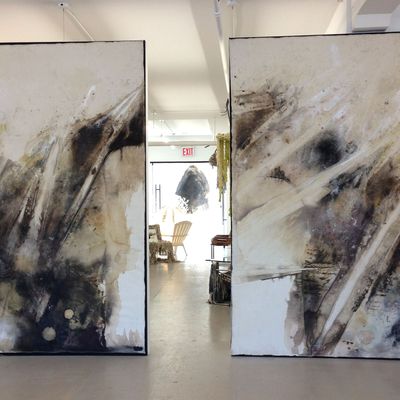
Think of the paintings of Lucy Dodd as very, very low-relief earthworks along the lines of Robert SmithsonÔÇÖs or Michael HeizerÔÇÖs. By making massive material processes and natural phenomena almost one-dimensional, DoddÔÇÖs work widens the senses, makes the cosmic thickening visible, and uncrumples something fundamental. Although just looking at (or sometimes smelling) her large begrimed art is exhilarating enough, I wanted to run my tongue on a couple of the paintings that the David Lewis Gallery checklist says contain leaf extract, wild walnut, yew berries, liquid smoke, and flower essence. Other works include nettles, black lichen, saliva, iron oxide, charcoal, and dog urine. Some have fermenting smells; one seems to be darkening before our eyes. In this way, DoddÔÇÖs paintings become two-dimensional animals with inbuilt chemistries, going through secret artistic caramelizations and painterly photosynthesis, converting liquids and semisolids into bliss. Mircea Eliade defined shamanism as ÔÇ£techniques of ecstasy.ÔÇØ I see these techniques in DoddÔÇÖs work. And the spirits of chaos.
DoddÔÇÖs whole show is like some fantastic voyage to our own collective archaic inner yurt, a place where painting exists in its larval stage. Hanging from the ceiling just outside the showÔÇÖs entrance is a large cowl-shaped, pancakelike thing streaked and swirled with painted spills and stains, white lines, and what look like weather patterns, tidal pools, and tiny nebulae. The long, narrow first gallery is garnished with altered furniture frames with weavings by Dodd, strange constructions, wooden blocks fashioned into antennae configurations, gathered materials hanging from above like rotting Spanish moss, scratchy drawings, and other tilting paintings. The experience is not of this art world ÔÇö like entering a fabulous abstract arbor made by a bowerbird, the creature that meticulously fashions structures from chewed berries, saliva, seashells, fruit, and flowers. Dodd is a bowerbird, or she turns us into bowerbirds; she seeks to draw us into her ripening world.
The large main gallery has a totally different atmosphere from the overstuffed entry. ThatÔÇÖs especially true because it is entered between two very large abstract paintings hung close enough together to squeeze us between them, as if to form a tall temple doorway. It is painting as gate and portal. Once inside we see three more large paintings. Two are oddly shaped, maybe parallelograms. All the outward chaos of the first gallery is transformed here into worlds coming into being, but on canvas. A lot of DoddÔÇÖs works just look like big, smudgy abstract backdrops sewn onto stretchers ÔÇö Twombly meets Beuys and Stingel. But the patterns, symmetries, fomenting blooms, swirls, and amniotic shapes take her work in other directions. Because each is so large and is made by sewing one sheet of canvas onto another and then stretching it, they have the physical presence of carpets, teepee covers, or animal pelts drawn tight for curing. All show smudges, scuffs, spills, and splotches; blottings here and there, flecks of charcoal, swipes, and stains of jewellike color. There are quasi-geometric areas, made perhaps by rubbing the canvas on corrugated cardboard, floorboards, or other patterned surfaces, that give the paintings structure and shifting internal scale. On closer inspection, the splotches and strokes seem the result of pours that have pooled and evaporated, leaving outlines of what look like fossil beds, zoological forms, crystals, or coral. ItÔÇÖs a cosmos that flips between microscopic, macroscopic, incubation chamber, and alchemist crucible. Each painting becomes a taxonomy of natural aesthetics and symmetries, a cosmic topography and record of its own making. That or Dodd has created colonies of charcoal-based mould spores that have organized themselves into larger living masses.
Dodd, who is 32, isnÔÇÖt some hocus-pocus shamanÔÇôwitch doctor ÔÇö although, at her opening, she and her friends prepared and served blue-green kombucha made from sarsaparilla root, mugwort, rose linden, and joy juice from urban moonshine. The drinks were served in carved-out cucumbers. Mine got me totally buzzed and humming, and I ate my cucumber cup, as well. I found myself having weird thoughts, like, ÔÇ£Maybe Lucy Dodd is Walter White, and sheÔÇÖs serving me liquid blue meth.ÔÇØ Meanwhile, in the main gallery, a bunch of people sat on a large canvas that was already turning into a painting beneath them. They were cutting vegetables, boiling water, and cooking catfish to serve later. Radicchio and cucumber stains were already on the canvas, but I was so stoned from the juice that I left.
I knew IÔÇÖd seen something fantastic unfolding, an artist who was probing paintingÔÇÖs ancient uses via abstraction, TwomblyÔÇÖs ideas of paint that looks like itÔÇÖs been applied straight from the human body, Sigmar PolkeÔÇÖs belief in paintingÔÇÖs transformative powers, and Robert RymanÔÇÖs desire to reduce painting to its bare bones to see how far these bones can go. Her art connects to other organizers of form and chaos, Jessica Jackson-Hutchins, Uri Aran, Catherine Ahearn, Andra Ursuta, Wendy White, Keltie Ferris, Sarah Braman, Anna Betbeze, Jeff Williams, and others. Buzzed or not, I knew IÔÇÖd seen one of the best shows of the year.
Lucy DoddÔÇÖs ÔÇ£Cake4CatfishÔÇØ is at David Lewis Gallery, 88 Eldridge Street, through January 12.

